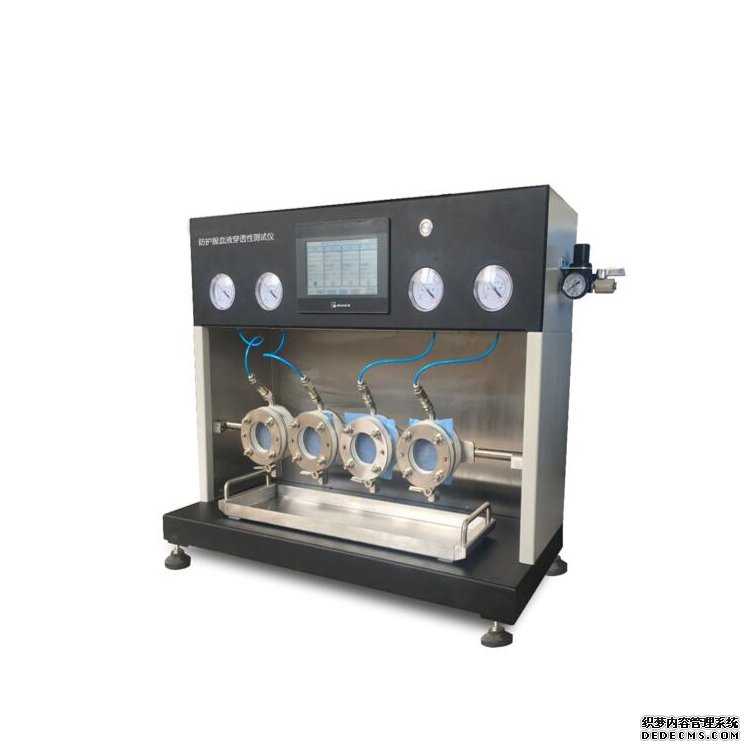Which standards apply to synthetic blood penetration resistance tester?
The most fundamental significance of masks or protective clothing is to protect users. In order to achieve the protection effect, the finished products have to be tested many times after being produced, and only those that fully meet the relevant standards can be put on the market.
The Synthetic Blood Penetration Tester is used to measure the jet penetration performance of synthetic blood and other liquid sources, so as to evaluate its safety protection performance. It is mainly used to test the permeability resistance of protective clothing to blood, body fluids, blood pathogens (tested with Phi-X 174 antibiotics), synthetic blood and other liquids. Applicable to the liquid permeation resistance of protective equipment such as gloves, protective clothing, outer covers, coveralls and boots.

First, medical protective clothing anti-blood penetration tester-vertical forensic protective clothing flame retardant tester spot applicable standard:
GB19083-2010: technical requirements for medical protective masks;
YY 0469-2011: Medical surgical masks;
YY/T0691-2008: Test method for penetration resistance of medical masks for infectious pathogen protection equipment to synthetic blood (fixed volume, horizontal injection);
ISO 22509:2004; F1862/F1862M-2013
ASTM F1671 Phi-X174 bacteriophage penetrability as a test system to determine the penetration resistance of protective clothing materials to blood-borne pathogens;
ASTM F1670 test method for penetration resistance of protective clothing materials to artificial blood:
ASTM F903 test method for liquid permeability resistance of protective clothing materials;
ISO 16603:2004 protective clothing for preventing contact with blood and body fluids-determination of permeability of protective clothing to blood and body fluids-synthetic blood test method;
ISO 16604:2004 protective clothing to prevent contact with blood and body fluids to determine the permeability of protective clothing materials to blood pathogens using Phi-X 174 antibiotic test method;
The test method of synthetic blood permeation resistance is used to evaluate the permeation resistance of medical masks under the impact of small volume (〜2 mL) high-speed synthetic blood flow.
The determination of qualified/unqualified medical masks is based on visual inspection of synthetic blood penetration.
The Synthetic Blood Penetration Resistance Tester test method of synthetic blood penetration testing machine for medical masks is not suitable for all forms or conditions of blood-borne pathogen exposure. Users of the test method must check the face exposure mode and evaluate whether the test method is suitable for their specific application.
This test method is mainly aimed at the performance of materials or some material structures in the test of synthetic blood penetration testing machine for medical masks. This test method cannot solve the design, structure or interface performance of the medical mask or other factors that may affect the overall protection of the medical mask and its operation (such as filtration efficiency and pressure drop). Procedures for measuring these properties are included in test methods F2101 and MIL-M-36954C.
The testing method of the testing machine does not solve the air permeability of the medical mask material or any other characteristics that affect the breathing comfort of the medical mask. The test method of synthetic blood penetration testing machine for medical masks does not evaluate the performance of medical masks in air transmission or in preventing the penetration of atomized body fluids deposited on medical masks.
The Protective clothing blood penetration testing machine can not solve all the safety problems related to the use of mask materials, but is only suitable for testing the resistance of protective clothing to synthetic blood penetration under different test pressures.
2021-02-24 14:08
- Related News
What's the difference between a hydraulic oil filter and a regular oil filter?
Interpretation of Paper Tear Strength Standards
What is the significance of the LA abrasion test?
What is a UTM machine used for?
What is the principle of a capillary rheometer?
What is the difference between conical and parallel twin-screw extruders?
What is the ISO standard for color fastness?
What is the use of a roundness tester?
The Role of Dust-Proof Robot Protective Clothing
What is the difference between Taber and Martindale abrasion tests?
